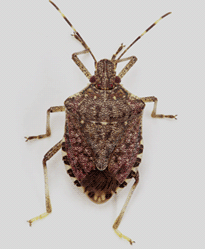It is the height of the annual war between homeowners and the Asian stink bug looking for overwintering shelter, and while there seems to be a truce, victory remains elusive.
“I would say that it is no longer a bad pest, but it is still a pest,” said Tracy Leskey, the research leader into the brown marmorated stink bug for the Department of Agriculture’s Appalachian Fruit Research Station.
“It’s not as acute a problem as it was a decade ago, but it is still a pest,” she said.
It’s thought that the stink bug, which gives off an offensive smell when challenged or killed, arrived from Asia in 2001 and quickly spread throughout the mid-Atlantic coast, reaching a peak in about 2010. It likes to overwinter in structures such as homes, and some said their houses were covered in the bugs.
Initially, farmers and homeowners tried traps and sprays, but the annual autumn march from fields, orchards, and vineyards continued.

Leskey’s team and others eventually found a natural pest in Asia, called the Samurai wasp, which lays its eggs in stink bug eggs, killing their hosts. As they tested the effectiveness of the wasp, it eventually was also imported into the United States and went to work on its own.
By late September this year, the overwintering population on the East Coast had dropped dramatically. “I think we can owe it to all of the natural enemies that are out there attacking brown marmorated stink bugs throughout the season,” Leskey said from her office in West Virginia.
But it’s not gone. It’s just moved on to states including Minnesota, Wisconsin, and Ohio.
The bug, said Leskey, “is really starting to invade in some of those areas. The natural enemies haven’t had time to catch up and really help regulate their populations as much as they do here locally.”
Brown marmorated stink bugs intercepted on their way to seek overwintering sites. Sorry, guys, first we need to science before you sleep. pic.twitter.com/Flqfdv1H2H
— Dr Tracy Leskey (@BMSBresearch) September 22, 2020
But in the mid-Atlantic, which saw the worst of the crisis, Leskey said, “we locally are not experiencing the massive wave of bugs that we did back in 2010 where literally people were sweeping them out of their homes with a broom.”
Asked if it will ever be eradicated, the research entomologist, already turning her attention to another invasive bug that is especially harmful to grapevines, the spotted lanternfly, shrugged.
How do SLF move? Learn more about movement and marking of spotted lanternfly by @LJ_nixon19 https://t.co/weIEzZUxed
— Dr Tracy Leskey (@BMSBresearch) January 27, 2021
“This is what I would describe as a legacy effect of the invasion of it being introduced. So, in other words, we still are dealing with it. I mean it’s not as bad, but we are still dealing with it. So, it arrived, and we learned a lot, and we can reduce the sort of catastrophic damage, but we still have to deal with it, and growers still have to deal with it. So, there’s almost like this legacy effect with some of these invasives when they come into the system. It adds another pest. It doesn’t go away completely,” she said.
